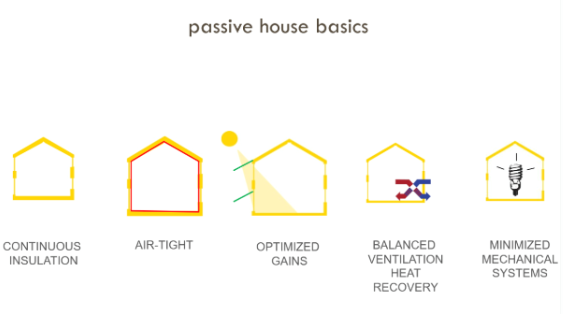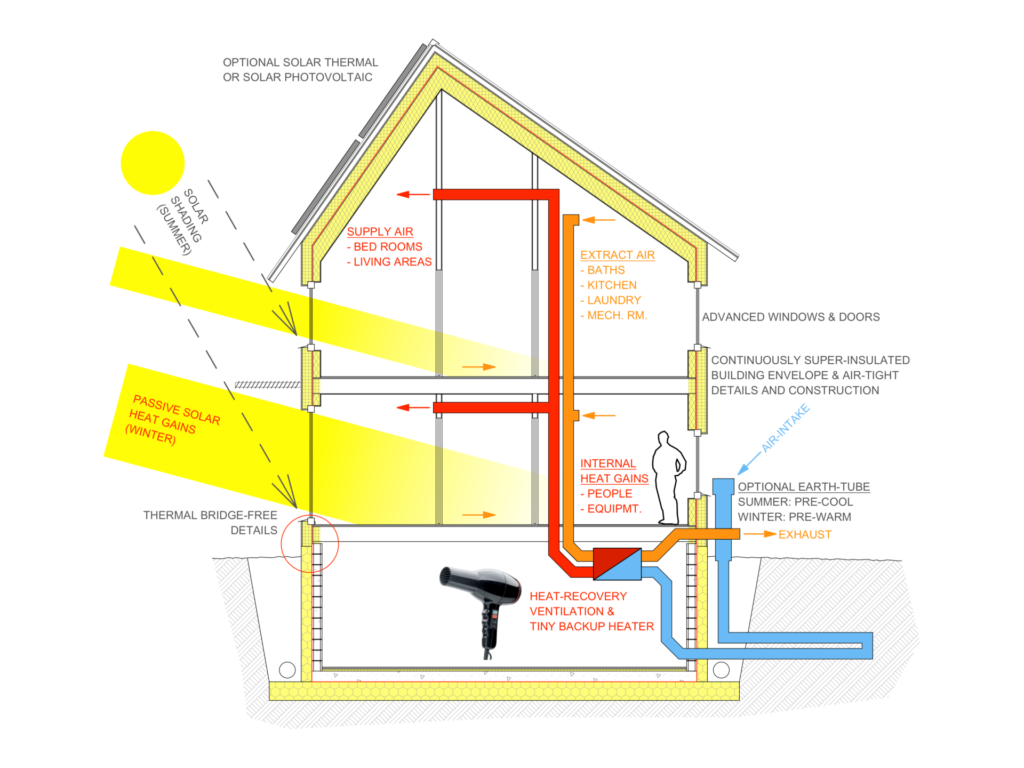What Is A "Passive House" Building?
Simply stated a ‘Passive House’ building is one designed, energy modeled and constructed to meet three rigorous performance criteria. The result is a building that resiliently coasts through power disruptions or systems malfunctions because it minimizes the size of energy-consuming systems and therefore its reliance on them – hence the term ‘Passive’.
– PHI (original Central European) criteria is constant
≤4.75 kBtu (1.39 kW) / ft2 [15 kWh / m2] annual heating demand, and
≤4.75 kBtu (1.39 kW) / ft2 [15 kWh / m2] annual cooling demand
OR
≤3.17 Btu/h (0.93 W) / ft2 [10 W /m2] peak hour heating load, and
≤2.54 Btu/h (0.74 W) / ft2 [7.96 W per m2] peak hour cooling load
regardless of climate zone (hot/humid, marine, mixed, cold/dry)
– PHiUS CORE or ZERO 2021 (United States and Canada) criteria varies by climate zone (less restrictive in hot/humid and cold/dry climates and more restrictive in milder/less extreme climates), the occupant load density and the building envelope surface area to floor area ratio
For example, climate zones in Southern Wisconsin/Northern Illinois the values average (presuming 2 occupants for first bedroom plus 1 occupant per each additional bedroom):
≤ 8.5 kBtu (2.5 kW) / ft2 [26.7 kWh / m2] annual heating demand
≤ 5.5 kBtu (1.61 kW) / ft2 [17.28 kWh / m2] annual cooling demand
OR
≤ 6.7 Btu (1.96 W) / ft2 [21.1 W / m2] peak hourly heating load
≤ 2.2 Btu (0.64 W) / ft2 [6.9 W / m2] peak hourly cooling load
Current U.S. and Canadian codes do not establish a maximum.
- PHI (original Central European) criteria is measured based upon interior building volume
≤0.6 ACH50 (1 Air Change/100 minutes) tested at 50 Pascals [1 lb./ft2]) - PHIUS CORE or ZERO 2021 (United States and Canada) criteria is based upon six sided building envelope surface area
≤0.05 CFM/ft250 (0.05 Cubic Feet/Minute) tested at 50 Pascals [1 lb./ft2] [0.2 w.g.]) [0.25 L/s * m2] or </= 0.08 CFM/ft2 (0.08 Cubic Feet/Minute) tested at 75 Pascals [1.5 lb.75 /ft2][0.3 w.g.] [0.375 L/s * m2]
Current U.S. and Canadian codes define air impermeable material as leaking ≤ 0.004 CFM/ft2 75 (0.02 L/s * m2) tested at 75 Pascals [1.5 lb./ft2] [0.3 w.g.][0.375 L/s * m2]
2021 ICC IECC commercial building provisions allow compliance if:
- Whole building envelope ≤ 0.4 CFM/ft2 75 (2.0 L/s * m2) tested at 75 Pascals [1.5 lb./ft2] [0.3 w.g.][0.375 L/s *m2]
- Specific building assemblies ≤ 0.04 CFM/ft2 75 (0.2. L/s * m2) tested at 75 Pascals [1.5 lb./ft2] [0.3 w.g.][0.375 L/s * m2]
- Specific building materials ≤ 0.004 CFM/ft2 75 (0.02 L/s * m2) tested at 75 Pascals [1.5 lb./ft2] [0.3 w.g.][0.375 L/s * m2] – same as air impermeable material
2021 ICC IECC residential building provisions allow compliance if:
- Whole building air volume ≤ 5 ACH50 (1 Air Change/12 minutes) tested at 50 Pascals [1 lb./ft2] [0.2 w.g.][0.25 L/s * m2] in climate zones 0 through 2
- Whole building air volume ≤ 3 ACH50 (1 Air Change/20 minutes) tested at 50 Pascals [1 lb./ft2] [0.2 w.g.][0.25 L/s * m2] in climate zones 3 through 8
- Dwelling and sleeping until enclosure </= 0.30 CFM/ft2 (1.5 L/s m2) tested at 50 Pascals [1 lb./ft2][0.2w.g.][0.25 L/s *m2]
– PHI (original Central European) criteria is constant
≤38.1 kBtu (11.2 kW) / ft2 (120 kWh / m2) annual source energy demand regardless of building occupancy type
– PHIUS CORE OR ZERO 2021 (United States and Canada) criteria is
≤ 3400 TO 6000 kWh /occupant for dwelling units (presuming 2 occupants for 1st bedroom plus 1 occupant for each additional bedroom) depending on climate zone, envelope surface area, and conditioned floor area
AND
≤34.8 kBtu (10.2 kW) / ft2 (109.6 kWh / m2) annual total source energy demand for all other occupancies
Inclusive of space heating/cooling/dehumidification, domestic (service) hot water production, miscellaneous electrical load [MEL] and auxiliary (energy harvesting systems equipment operation) electricity
Current U.S. and Canadian codes do not establish a maximum.
Source (primary), unlike site (final) energy includes the amount of energy it took to harvest fuel source, transport it to energy conversion plant (i.e. electrical plant or fuel refinery) and transport or transmit it to site. In the US, factors for converting site (final) energy to source (primary) are 1.1 for all fuels other than electricity and between 2.894 and 4.022 depending on which of the 4 electric grids the site/building is connected. (Source – US EIA and 2021 ICC IECC) PHIUS CORE or ZERO 2021 use 1.8 based upon the US national weighted average conversion losses of 14 sources of interconnected grid electricity ‘fuels’ NREL products will be grid electricity production sources by 2050.
In order to achieve good indoor air quality (hygiene) both PHI and PHIUS recommend maintaining an average intentional outdoor air mechanical ventilation rate (at between 0.3 and 0.4 ACH in residential dwellings and higher/lower rates in other
occupancies depending on the occupant load density).
(mechanical rate may reduce during no or low occupant load and when natural ventilation is provided and should rise during times of high occupant load, elevated indoor humidity or elevated indoor odor)
Current U.S. codes require mechanical ventilation systems for most occupancies and the code required rate rates are lower than recommended by PHI and PHIUS
The Passive House mantra – First, reduce demand so dramatically and permanently that it’s possible to maintain comfort with no or very little added energy, and then, harvest most or all of the energy required to satisfy the dramatically smaller demand for current day conveniences and comfort on site.
What are the ?
Abundant and Continuous insulation (6 sides) without Thermal Bridges
Exceptionally airtight building envelope (6 sides)
Optimized solar gains and shading
Balanced outdoor (air) supply = exhaust ventilation with heat and humidity recovery
Correctly sized to minimized loads and energy-efficient systems
Low Lifetime Cost of Ownership
Superior Indoor Comfort – Exterior Wall to Exterior Wall, Bottom Floor Slab to Top Floor Ceiling
Superior Indoor Air Quality/Hygiene for Individual, Family, and Other Occupants
Durable Building Envelope Assemblies (Mitigation of long term moisture accumulation)
Resiliency to coast through inevitable utility power outages and building system malfunctions
Does a ‘Passive House’ Building look different than other buildings?
In short – NO. Passive House is about building energy performance not style shape or style. In order to meet the required performance criteria there may be some noticeable differences in detail such as:
Thicker exterior envelope - foundation, roof and walls (with deeper exterior or interior windows / door recess)
Orientation of larger or smaller glazing toward or away from solar radiation (the sun)
Overhead and side/vertical glazing shading devices (roof overhangs, recessed windows, other overhead or side mounted shading devices) to prevent solar radiation gains when they are undesirable
Varying glazing types (U value, Solar Heat Gain Coefficient) depending on climate or orientation
Strategically location operable windows at lower and upper floor levels in climates/seasons where nighttime natural 'stack' ventilation may be implemented.
See PHIUS Pre-certified and Certified projects database for #1238 and other projects
How is creating a Passive House Building achieved?
Accomplishing Passive House performance criteria requires detailed and diligent energy modeling/calculations (by a Certified Passive House Consultant CPHCSM , detailed drawings and specifications (by an Architect or CPH Designer familiar with and experienced in Passive House design and detailing) and quality assurance procedures (by PHIUS energy model and detailed drawing/specification review (pre-certification/registration) and qualified third party testing/documentation of building envelope, mechanical/plumbing/electrical systems during construction and documentation of same to PHIUS (final certification).
Passive House does not mandate or reward specific strategies or systems, nor is there a list of required techniques to meet the performance criteria. Approach/strategy is flexible and up to the designer’s and builder’s discretion/creativity.
During and at the end of construction, inspections and tests are performed by a qualified independent Rater to insure conformance with the energy model inputs/outputs and detailed drawings or specifications.
By achieving PHIUSCORE or ZERO 2021 certification, simultaneous US Department of Energy’s Zero Energy Ready Home (ZERH) status is achieved. There is also the option to earn the US Environmental Protection Agency’s Indoor Air Plus Label.
Prior to construction energy model and detailed drawings/specifications are submitted for review and pre-certification/registration to the Passive House Institute US (PHIUS).
If the building is to be final certified, inspections and tests by the qualified independent Rater must be documented and submitted to PHIUS for approval.
A team of dedicated and passionate team of professionals working together with the building owner insures meeting the goal of Passive House performance and the benefits it offers the building owner and the building occupants.
See PHIUS+ Certification process overview for more information.
Also see Passive House Alliance for further information regarding and in support of Passive House


